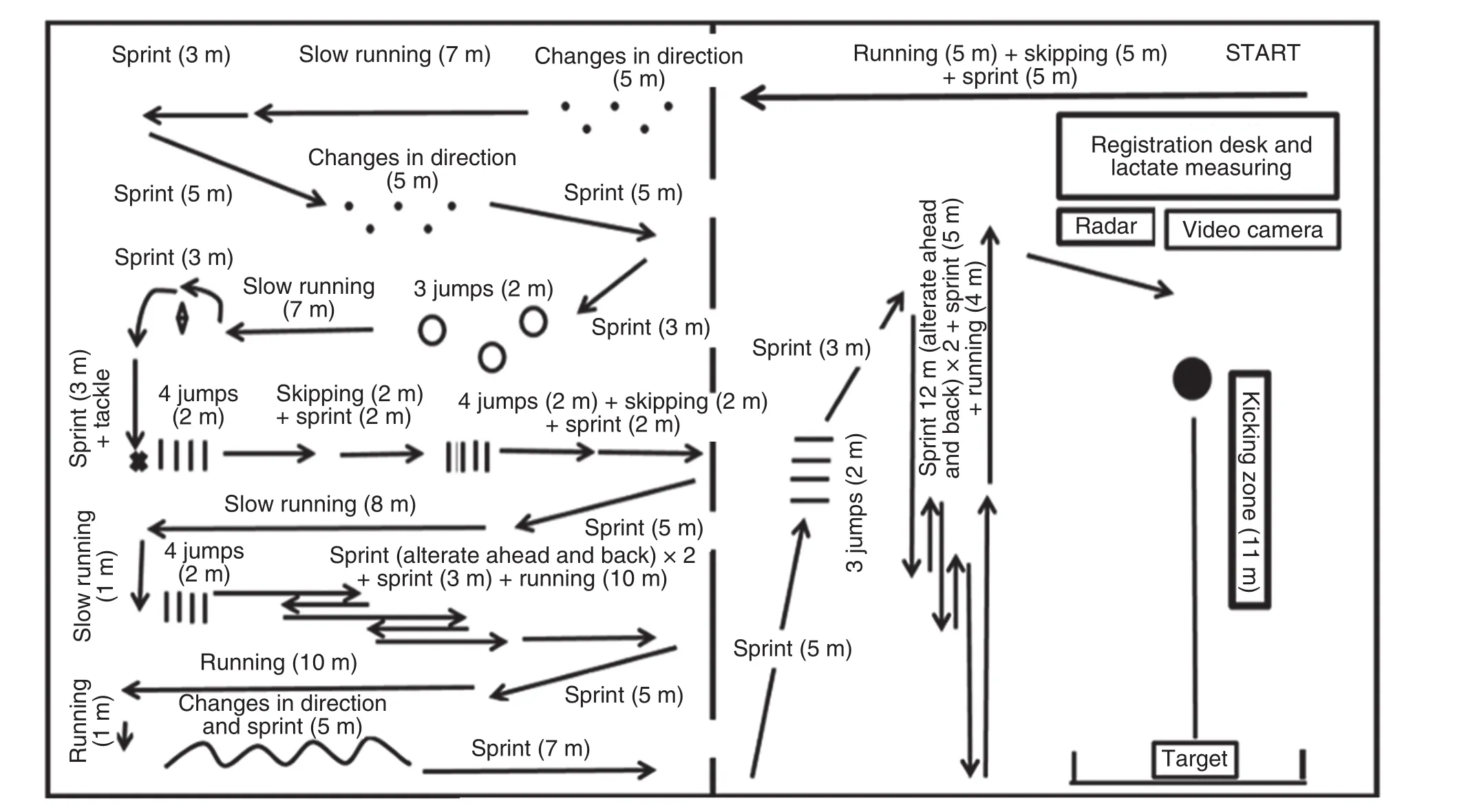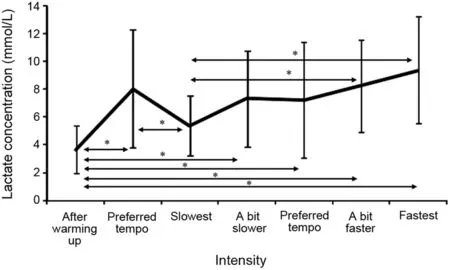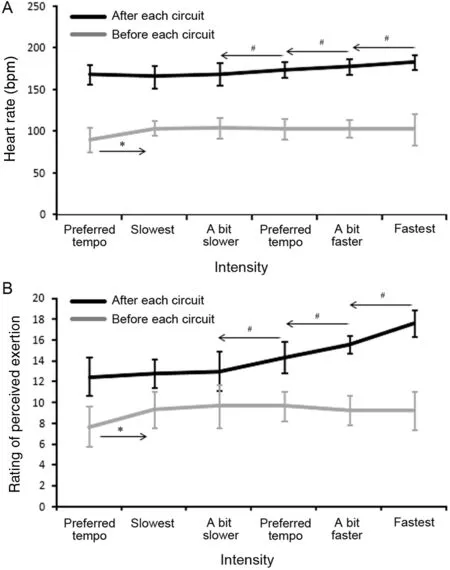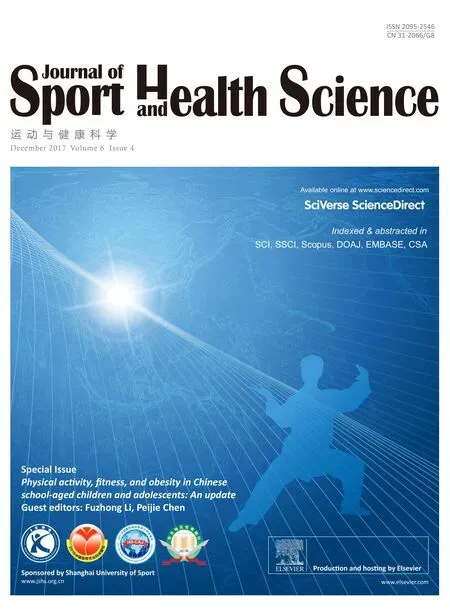The influenc of different exercise intensities on kicking accuracy and velocity in soccer players
Riardo Ferraz *,Roland van den Tillar,Mario C.Marques
a Department of Sports Sciences,University of Beira Interior,Convento de St António,Covilhã 6200-001,Portugal
b Research Center in Sport Sciences,Health Sciences and Human Development,CIDESD,Vila Real 5000-801,Portugal
c Department of Teacher Education,Nord Trøndelag University College,Levanger 7600,Norway
1.Introduction
Exercise intensity in sports is an aspect that determines the characteristics of effort and,consequently,is also an important factor for control and regulation of training.1,2The type of intensity developed in each sport determines its specificit of effort.Particularly in soccer,the type of effort is intermittent due to permanent changes in intensity,including alternation between critical moments of high-intensity and moments of near rest.2–4In fact,in soccer,there seems to be 2 patterns of effort:the pattern as a result of short-term high intensity effort and the pattern as a result of long-term exercise.5,6
In general,regarding high-intensity efforts,soccer players perform 150–200 brief,powerful actions during a game;for example,sprinting,changing pace and direction,tackling,accelerations,decelerations,and jumping.2This high level of intensity is considered decisive in soccer and causes high levels of fatigue,which affect the player’s performance during a game.4,5,7
However,the importance of intensity in soccer activities is not limited to high-intensity moments.In fact,the game is also characterised by lower levels of intensity representative of the other type of actions that are also required during the game.1,4,5Because of this,it would be interesting to determine the influence of lower and different intensities on player performance.It is known that each level of intensity requires different levels of strength and endurance in relation to each action.1,5Therefore,each action can be conditioned by the state of temporary and accumulated fatigue in players;thus,these aspects have consequences on tactical and technical performance.1,4,5,7Because of this possible connection between exercise intensity,fatigue,and player performance,it would be interesting to better understand the influenc of different intensities on soccer performance,particularly on kicking,as it is considered an important parameter for success in soccer.4,8
In terms of kicking performance as a result of high exercise intensity,results of previous studies showed a possible negative effect on motor coordination and a reduction of movement stability,especially in knee and hip range of motion,which is mainly due to fatigue.4,9,10Rampinini et al.7reinforced this idea when it was found that short passing ability decreased both during a game and after brief bouts of high-intensity activities.
However,a recent study11showed that this classical idea of the negative cause/effect relationship between high-intensity activities and performance skills cannot be linear,but should be variable and consider aspects such as self-unconscious effort regulation(pacing strategy),the importance of the role of perceived exertion in relation to the exercise,and the critical importance of psychological aspects:all of which were supported in recent fatigue studies.12–19In addition,other previous studies also concluded that soccer skills were not affected(and kicking during soccer was only minimally affected)after high-intensity exercises.1,20These studies advance a muscular reason,stating that knee extensor muscle strength remained unaffected in all exercise trials.1
Thereby,and despite the differences between the protocols used that can explain differences in the results,it seems to be expected and desirable that the investigation about the impact of different intensities on kicking performance should continue;the studies are still inconclusive,but new conclusions continue to emerge.Furthermore,most research is very focused on the effect of high-intensity efforts.In our opinion,it also seems important to understand what happens during kicking after different intensities of exercise(not only after high-intensities).Additionally,we also consider it is important to use a protocol with activities/exercises related to training and games.
Therefore,the aim of this study was to investigate the effect of different intensities induced by a soccer specifi protocol upon kicking ball velocity and the target-hitting accuracy of soccer players.Although kicking performance is considered crucial for successful soccer performance,there is limited information regarding this interaction with different exercise intensities.It was hypothesised that different intensities may result in different levels of fatigue,which may affect kicking performance.Still,progressive exercise intensity may cause progressive levels of fatigue,which can result in progressive kicking performance deterioration.However,and according to recent studies,it is possible that the effect is minimal,and not linear or progressive;1,5,11because of this,it is also possible that,with a moderate and chosen intensity,performance can be expected to increase more so than in higher or lower intensities.
2.Methods
2.1.Participants
Twelve semi-professional male football players (age 19.7±4.9 years;height1.79±0.56m;weight703.14±77.47N;training experience 13.0±5.6 years)playing in the second division of the Norwegian National Competition in competitive period participated in this study.The subjects were fully informed about the protocol before participating in this experiment.Informed consent,in accordance with the recommendations of the Ethics Committee of the Scientifi Council of PhD Course in University of Beira Interior and current ethical standards in sports and exercise research,was obtained prior to all testing from all subjects.
2.2.Design
A repeated-measures design with a group of active amateur soccer players was used to determine the influenc of different intensities(fatigue)on kicking ball velocity and accuracy of soccer player subjects.
2.3.Procedures
An adaptation of the Ferraz et al.11protocol was used.The subjects had a familiarisation session 1 week before in which they,as a part of the warm-up,completed the circuit.This was done to avoid the learning effect.After a general warm-up of 15m in,which included jogging and kicking drills,kicking performance was tested from 11m(penalty kick).A standard soccer ball(mass approximately 430 g with a circumference of 70 cm)was used.The instruction was to kick a regular ball with maximum force and attempt to hita target from 11m away;the target was a 1m×1m circle that was 1m off the ground and located in the middle of a goal(7.32m×2.44m).Three attempts per condition were made.
After 3 kicks,the participants started the circuit at intensity 3(their own preferred tempo)to obtain an idea of what their preferred tempo was.Then,all intensities were randomised(including intensity 3)to avoid a learning and/or fatigue effect.The random order was based on a random number generator.The circuit consisted of a set of specifi and explosive exercises including jumping,skipping,multiple quick changes of direction,driving the ball,passing,bursts of sprinting and slow running(Fig.1).The 5 different prescribed intensities were:
Slowest–Perform the circuit slowly and comfortably.
A bit slower–Perform the circuit at a tempo that is a bit slower than your own preferred tempo(a bit slower).
Preferred tempo–Perform the circuit at your preferred tempo.
A bit faster–Perform the circuit at a tempo that is a bit faster than your preferred tempo but not as fast as possible.
Fastest–Perform the circuit as fast as possible.
After each circuit,the participants had to kick the ball 3 times.After the 3 kicks,the participants had 5m in to rest and recover so that the previous intensity did not have an influenc on the next intensity.
2.4.Measurements
The kicking ball velocity of the ball was determined using a Doppler radar gun(Sports Radar 3300;Sports Electronics Inc.,Dayton,OH,USA)with±0.028m/s accuracy within a fiel of 10°from the gun.The radar gun was located 2m behind the 11m line at ball height during the kick.The average kicking ball velocity after each circuit was used for further analysis.

Fig.1.Circuit design.
Kicking accuracy was measured with avideo camera(HDRFX 100;Sony,Tokyo,Japan)placed at a distance of 12m from the goal.The camera was positioned so that the subject did not obstruct the fiel of vision between the camera and the goal.The position of the center of the ball was measured at the momentit struck the goal.Mean radial error(MRE),as described by van den Tillaar and Ettema,21was used as a measurement of accuracy.MRE was measured as the average of absolute distance to the centre of the target.
The time of each circuit was also measured.Participants wore a pulse belt(RS300x;Polar,Oulu,Finland)for the duration of the experiment.Heart rate(HR)was measured immediately following the completion of a circuit and just before the start of the next one,as was the rating of perceived exertion(RPE),which was on a 20-point Borg scale.22Lactate was measured after the warm-up and directly after the 3 kicks following each circuit.Blood was taken from the finge tip,and a lactate measurement was performed using a portable machine(Roche Accutrend Lactate Test Strips;Roche,Basel,Switzerland).
2.5.Statistical analyses
To assess differences in maximal ball velocity,a repeated analysis of variance(ANOVA)was used for kicking accuracy,HR,lactate,RPE,and time of each circuit.Post hoc comparisons with Holm-Bonferroni corrections were conducted to locate differences.All results are presented as mean±SD.Where sphericity assumptions,measured by the Mauchti’s tests of sphericity,were violated,Greenhouse–Geisser adjustments of the p values were reported.The level of significanc was set at p<0.05.Effect size was evaluated with η2where 0.01<η2≤0.06 constitutes a small effect,0.06<η2≤0.14 constitutes a medium effect,and η2>0.14 constitutes a large effect.23Statistical analysis was performed with SPSS Version 18.0(SPSS Inc.,Chicago IL,USA).
3.Results
The time to cover the circuit,average kicking ball velocity,and accuracy were not significant y different when perform ing the circuit directly after the warm-up compared to the later circuits(p≥0.14,Figs.2 and 3),contrary to the lactate concentration which was significant y different(p<0.05,Fig.4)except in comparison with the slowest one.HR and RPE were significant y(p≤0.02)higher when performing the circuit at the preferred tempo for the second time(Fig.5).The time used for completing the circuit was significant y shorter after each circuit when the intensity was increased(F(5,50)=74.9;p<0.001;η2=0.88;Fig.2).

Fig.2.Time used to cover the circuits at different intensities.*p<0.05,compared with all next intensities;#p<0.05,compared with all intensities except with preferred tempo and a bit slower.

Fig.3.Average ball velocity(A)and accuracy(B)at the different intensities averaged over all participants(mean±SD).*Indicates a significan difference between 2 intensities(p<0.05).
Average(F(6,66)=2.3;p=0.041;η2=0.18)ball velocity was significant y affected after completion of the circuit.A post hoc comparison showed that the ball velocity only decreased significant y at the highest intensity compared with all others,except with the one after the warm-up and the slowest performed circuit(Fig.3A).Accuracy(F(6,66)=0.19;p=0.98;η2=0.02)did not significant y change during the protocol(Fig.3B).

Fig.4.Lactate concentration after each circuit at the different intensities averaged over all participants(mean±SD).*Indicates a significan difference between 2 intensities(p<0.05).

Fig.5.Heart rate(A)and rating of perceived exertion(B)before and after each circuit at the different intensities averaged over all participants(mean±SD).*p<0.05,compared with all next intensities right of the sign;#p<0.05,compared with all next intensities left of the sign.
Lactate concentration changed significant y during the protocol(F(6,66)=4.81;p<0.001;η2=0.3).A post hoc comparison showed that lactate concentration was significant y lower directly after the warm-up compared with most intensities(except the slowest one).Furthermore,the lactate concentration was only significant y higher after the faster and fastest conducted circuits compared to the slowest circuit(Fig.4).
HR and RPE before the start of each circuit changed signifi cantly(F(5,40)≥4.07;p<0.04;η2≥0.27).A post hoc comparison revealed that HR and RPE only increased significant y from the preferred tempo intensity directly after the warm-up with all other intensities.When HR and RPE were measured after each circuit,they increased significant y over the exercise period(F(5,45)≥12.7;p<0.001;η2≥0.59).A post hoc comparison revealed that both HR and RPE significant y increased after every intensity,from the slower to the fastest circuit(Fig.5).
4.Discussion
The main finding of the current study showed that maximal ball velocity was affected only after the most intense circuit,while accuracy was not affected in the protocol.The increased intensity corresponded to the expected decrease in duration in each circuit and the increase of fatigue,as demonstrated by HR,RPE,and lactate.Our results suggest that kicking performance(ball velocity)is only affected after high-intensity exercises.Lower exercise intensities do not affect accuracy or kicking ball velocity.
Parts of these results are in accordance with previous studies about the effect of high-intensity exercises on kicking soccer balls.The studies reported the possible negative effect explained by biomechanical and physiological causes such as generated muscle incapacity with a decrease in strength,reduction of movement stability(especially in knee and hip range of motion),or a decrease of limb velocity.10,24–30
A previous study5that researched the variations between different exercise intensities also reported a detrimental effect on passing skill performance after high levels of localised fatigue.These finding are consistent with soccer-specifi research,31which observed a detriment in the psychomotor performance of players following exhausting levels of exercise.
However,contradictory results were found by McMorris et al.20considering passing skills.They found that performance in rest and high-intensity exercise did not differ.Also,Ferraz et al.,11according to the most recent fatigue theories and using a repetitive high-intensity protocol(exhaustion protocol),concluded that maximal ball velocity on kicking was also affected,but this effect was not linear or progressive and might be dependent upon factors other than those relating to physiology.1,19Another similar study1concluded that kicking accuracy and short passing ability were only minimally affected by high intensity activities immediately post-exercise,but recovered thereafter in the case of kick.
The differences in the exercise protocols used in these studies may condition a comparative analysis of the results and can explain part of the contradictory outcomes.The majority of the studies pointed that high-intensity exercise was a potential negative factor on kicking performance due to fatigue.However,this potential was not found to be negative and could have been variable.11It is also known that,in successive repetitions at a high-intensity,the influenc of fatigue may not always be the same;there may even be no practical effects on the performance of the kick,even if the player is exhausted.11
Another point of discussion is the comparison between the intensity of the firs and second selected tempo.No differences in kicking performance(Fig.3),time(Fig.2),and lactate(Fig.4)were found indicating the participants were pretty good in the perception of the prescribed intensity.Only the HR and RPE after the circuit was higher(Fig.5),but that can be explained by the fact that after the firs selected tempo,the participants were not so fatigued,while after the second tempo the participants have already performed several circuits with different intensities.Due to the random order of these intensities,some participants could have been more fatigued and were therefore not fully recovered from the previous one,which increased the HR and RPE more in the second time.32
However,it is also possible that at the second selected tempo,the pacing strategy used was more tiring(more intense),although it was not reflecte inmost of the remaining values;it was,however,reflecte in HR and RPE,probably due to stronger overall coupling among the two.32Thus,it seems that,during the protocol,the perception of selected tempo changed and,according to recent studies,perhaps the player modulated their effort,and the auto-regulation became slightly more aggressive,even without significan results in kicking performance.11,15,16,19This findin shows a possible evidence that there may be mechanisms(not only physiological)that can influenc players during exercise.
Regarding kicking accuracy,no effect was found.Conversely,some studies reported a negative effect on kicking accuracy in high-intensity efforts due to changes in coordination by inherent physiological causes:26,29approach speed,skill level,1,33blood lactate level and decreased muscle glycogen in connection with impaired neuromuscular performance affecting coordination and,consequently,soccer skills.34Otherwise,similar effects on kicking accuracy were found in a recent and related study,1which showed that soccer skill performance was only minimally affected by acute resistance exercise independent of intensity because knee extensor muscle strength remained unaffected during protocol application.In addition,Ferraz et al.11did not fin any effect on kicking accuracy,which was similar to a study by van den Tillaar and Ulvik35that showed that kicking accuracy could only be affected when the main priority in instruction was upon hitting the target.
Future studies should focus upon kinematic analyses of coordination and strength patterns to investigate the changes that occurred after high intensity activities.It would give a better understanding about the possible impact of the mechanisms(not only physiological)that can influenc the player during exercise,especially the possible role of the psychophysiological aspects that should continue to be explored,in relation to the high intensity exercises,especially in team sports such as soccer.
5.Conclusion
Kicking soccer velocity was conditioned by high-intensity exercises.Additionally,we concluded that low and moderate exercise intensities did not affect the performance of the kick,and the intensity of exercise did not influenc accuracy.A possible negative effect of fatigue due to high-intensity exercises and possible changes related to patterns of coordination and strength were considered.Otherwise,it is possible that other mechanisms(not only physiological)could influenc players during the exercises,but more studies are needed to confim and develop this hypothesis.
Acknowledgment
The present work was supported by Portuguese Foundation for Science and Technology(FCT)Grant(SFRH/BD/71470/2010)under the Human Potential Operating Program,supported by the European Social Found.
Authors’contributions
RF,RT,and MCM conceived of and designed the experiments;RF and RT performed the experiments;RF and RT analyzed the data;RF,RT,and MCM drafted the manuscript.All authors read and approved the fina version of the paper,and agree with the order in which the authors are presented.
Competing interests
The authors declare that they have no competing interests.
1.Draganidis D,Chatzinikolaou A,Jamurtas AZ,Barbero JC,Tsoukas D,Theodorou AS,et al.The time-frame of acute resistance exercise effects on football skill performance:the impact of exercise intensity.J Sport Sci 2013;31:714–22.
2.Mohr M,Krustrup P,Bangsbo J.Match performance of high-standard soccer players with special reference to development of fatigue.J Sport Sci 2003;21:519–28.
3.Bangsbo J.The physiology of soccer—with special reference to intense intermittent exercise.Acta Physiol Scand Suppl 1994;619:1–155.
4.Rampinini E,Impellizzeri FM,Castagna C,Coutts AJ,Wisløff U.Technical performance during soccer matches of the Italian Serie A league:effect of fatigue and competitive level.J Sci Med Sport 2009;12:227–33.
5.Lyons M,A l-Nakeeb Y,Nevill A.Performance of football passing skills under moderate and high-intensity localized muscle fatigue.J Strength Cond Res 2006;20:197–202.
6.Szgula Z,Gawronski W,Kalinski MI.Fatigue during exercise.Polish J Sports Med 2003;7:57–67.
7.Rampinini E,Impellizzeri FM,Castagna C,Azzalin A,Bravo DF,Wisløff U.Effect of match-related fatigue on short-passing ability in young football players.Med Sci Sports Exerc 2008;40:934–42.
8.Russell M,Benton D,Kingsley M.The effects of fatigue on soccer skills performed during a soccer match simulation.Int J Sports Physiol Perform 2011;6:221–33.
9.Drust B,Reilly T,Cable NT.Physiological responses to laboratory-based soccer specifi intermittent and continuous exercise.J Sport Sci 2000;18:885–92.
10.Rahnama N,Reilly T,Lees A,Graham-Smith P.Muscle fatigue induced by exercise simulating the work rate of competitive soccer.J Sport Sci 2003;21:933–42.
11.Ferraz R,van den Tillar R,Marques C.The effect of fatigue on kicking velocity in soccer players.J Hum Kinet2012;35:97–107.
12.Amann M,Dempsey JA.Locomotor muscle fatigue modifie central motor drive in healthy humans and imposes a limitation to exercise performance.J Physiol 2008;586:161–73.
13.Amann M,Secher NH.Point:afferent feedback from fatigued locomotor muscles is an important determinant of endurance exercise performance.J Appl Physiol(1985)2010;108:452–4.
14.Marcora SM,Staiano W.The limit to exercise tolerance in humans:mind over muscle?Eur J Appl Physiol 2010;109:763–70.
15.Mauger AR,Jones AM,Williams CA.Influenc of feedback and prior experience on pacing during a4-km cycle time trial.Med Sci Sports Exerc 2009;41:451–8.
16.Millet GY.Can neuromuscular fatigue explain running strategies and performance in ultra-marathons?The Flush Model.Sports Med 2011;41:489–506.
17.Noakes TD.Fatigue is a brain-derived emotion that regulates the exercise behavior to ensure the protection of whole body homeostasis.Front Physiol 2012;3:82.doi:10.3389/fphys.2012.00082
18.Noakes TD,St Clair Gibson A,Lambert EV.From catastrophe to complexity:a novel model of integrative central neural regulation of effort and fatigue during exercise in humans:summary and conclusions.Br J Sport Med 2005;39:120–4.
19.Swart J,Lamberts RP,Lambert MI,Lambert EV,Woolrich RW,Johnston S,et al.Exercising with reserve:exercise regulation by perceived exertion in relation to duration of exercise and know ledge of endpoint.Br J Sport Med 2009;43:775–81.
20.McMorris T,Gibbs C,Palmer J,Payne A,Torpey N.Exercise and performance of a motor skill.Br J Phys Educ Res 1994;15:23–7.
21.van den Tillaar R,Ettema G.A three-dimensional analysis of overarm throwing in experienced handball players.J Appl Biomech 2007;23:12–9.
22.Borg GA.Perceived exertion:a note on “history”and methods.Med Sci Sport1973;5:90–3.
23.Cohen J.Statistical power analysis for the behavioural sciences.2nd ed.Hillsdale,NJ:Lawrence Erlbaum Associates;1988.
24.Forestier N,Nougier V.The effects of muscular fatigue on the coordination of a multijoint movement in human.Neurosci Lett 1998;252:187–90.
25.Gates DH,Dingwell JB.The effects of muscle fatigue and movement height on movement stability and variability.Exp Brain Res 2011;209:525–36.
26.Ismail A,MansorM,Ali M,Jaafar S,Makhtar K.Biomechanical analysis of ankle force:a case study for instep kicking.Am J Appl Sci 2010;7:323–30.
27.Kellis E,Katis A,Vrabas IS.Effects of an intermittent exercise fatigue protocol on biomechanics of soccer kick performance.Scand J Med Sci Sports 2006;16:334–44.
28.Rodacki AL,Fowler NE,Bennett SJ.Multi-segment coordination:fatigue effects.Med Sci Sports Exerc 2001;33:1157–67.
29.Gribble PA,Hertel J,Denegar CR,Buckley WE.The effects of fatigue and chronic ankle instability on dynamic postural control.J Athl Train 2004;39:321–9.
30.Sparto PJ,Parnianpour M,Reinsel TE,Simon S.The effect of fatigue on multijoint kinematics,coordination,and postural stability during a repetitive lifting test.J Orthop Sports Phys Ther 1997;25:3–12.
31.Chmura J,Jusiak R.Changes in psychomotor performance of soccer players subjected to an exercise test.Biol Sport1994;11:197–203.
32.Green JM,McLester JR,Crews TR,Wickwire PJ,Pritchett RC,Redden A.RPE-lactate dissociation during extended cycling.Eur J Appl Physiol 2005;94:145–50.
33.Lees A,Nolan L.The biomechanics of soccer:a review.J Sports Sci 1998;16:211–34.
34.Ekblom B.Applied physiology of soccer.Sports Med 1986;3:50–60.
35.van den Tillaar R,Ulvik A.Influenc of instruction on velocity and accuracy in soccer kicking of experienced soccer players.J Mot Behav 2014;46:287–91.
 Journal of Sport and Health Science2017年4期
Journal of Sport and Health Science2017年4期
- Journal of Sport and Health Science的其它文章
- Correlates of long-term physical activity adherence in women
- The effects of aerobic exercise training on oxidant-antioxidant balance, neurotrophic factor levels, and blood-brain barrier function in obese and non-obese men
- Empowering youth sport environments:Implications for daily moderate-to-vigorous physical activity and adiposity
- School and community physical activity characteristics and moderate-to-vigorous physical activity among Chinese school-aged children:A multilevel path model analysis
- Prevalence of physical fitnes in Chinese school-aged children:Findings from the 2016 Physical Activity and Fitness in China—The Youth Study
- Overweight,obesity,and screen-time viewing among Chinese school-aged children:National prevalence estimates from the 2016 Physical Activity and Fitness in China—The Youth Study
